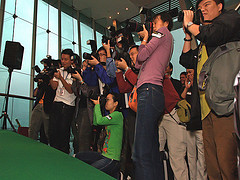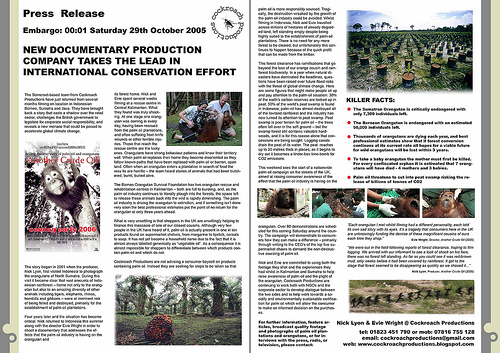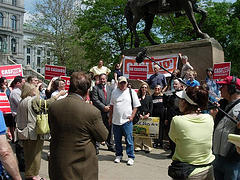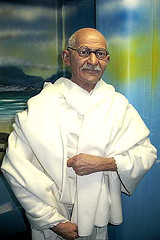Life Skills Development/Unit Three/Public Realtions/Lesson
Contents
[hide]What is public relations and what does it involve?
Public Relations
- Is the art of managing communication between an organization and its key publics to build, manage and sustain a positive image
- Is the process of aligning the perceptions of targeted audiences (or publics) with the current realities and reasonable prospects of another entity
Building, managing and sustaining a positive image is key to public perceptions and persuasion to you business message. Public relations involve:
- Evaluation of public attitudes and opinions
- Formulation and implementation of an organization's procedures and policy regarding communication with its publics
- Developing rapport and good-will through a two way communication process
- Fostering a positive relationship between an organization and its public constituents
The following are some of the things that have been proven effective strategies in gaining good public relations.
How can my organisation build a positive image for itself?
External Image Building Elements
Audience targeting
A fundamental technique used in public relations is to identify the target audience, and to tailor every message to appeal to that audience. In addition to audiences, there are usually stakeholders, literally people who have a "stake" in a given issue. All audiences are stakeholders, but not all stakeholders are audiences. For example, a charity commissions a PR agency to create an advertising campaign to raise money to find a cure for a disease. The charity and the people with the disease are stakeholders, but the audience is anyone who is likely to donate money.
Press conference
A press conference consists of someone speaking to the media at a predetermined time and place. Press conferences usually take place in a public or quasi-public place. They provide an opportunity for speakers to control information and who gets it; depending on the circumstances, speakers may hand-pick the journalists they invite to the conference instead of making themselves available to any journalist who wishes to attend. It is also assumed that the speaker will answer journalists' questions at a press conference, although they are not obliged to.
Press release
A press release is a written statement distributed to the media. It is a fundamental tool of public relations. Press releases are usually communicated by a newswire service to various news media and journalists may use them as they see fit. Very often the information in a press release finds its way verbatim or minimally altered, to print and broadcast reports.
The advent of the Internet has ushered in a new kind of press release known as an optimized press release. Unlike conventional press release, written for journalists' eyes only, in hopes the editor or reporter would find the content compelling enough to turn it into print or electronic news coverage, the optimized press release is posted on an online news portal. Here the writer carefully selects keywords or keyword phrases relevant to the press release contents.
Lobby groups
Lobby groups are established to influence government policy, corporate policy, or public opinion. These groups purport to represent a particular interest. When a lobby group hides its true purpose and support base it is known as a front group.
Astroturfing
The term astroturfing describes formal public relations (PR) campaigns which seek to create the impression of being a spontaneous, grassroots behavior. Hence the reference to the "AstroTurf" (artificial grass) is a metaphor to indicate "fake grassroots" support. The goal of such campaign is to disguise the agenda of a client as an independent public reaction to some political entity
However, these strategies are futile if the goals and values of the employees are not aligned with those of the organization. Behind everything that an organization says and does are its members, so building the image or your organization will depend solely on what members you have. You must communicate the goals and ideals of your organization to your members, as they are the organization's ambassadors to the general public.
How can I, as a member, build a positive image for my organisation?
Institution Strengthening and Internal Image Building;
Qualities of an Effective Ambassador
Each employee is an ambassador of their organization, representing its image and as a consequence its interest. How you perform as your organisation’s representative reflects on your organisation as well as on you. If the values of your organisation are embodied in the way you present yourself, other people gain a clearer understanding of your corporate attitudes and concerns.
There are four elements to the ambassador role:
- “Relationship builders”- interact with bodies such as government, the press and trade groups.
- “Salespeople”- go out there and make deals.
- “Melders”- keep the team together through their appreciation of personalities and adroit handling of their own internal politics.
- “Information acquisitors”- know huge amounts about the organization and ensure that they retain control in that manner.
For an employee to fulfill these sub-roles effectively it is necessary for him or her to strongly identify with the organization. A person is strongly identified with an organization when (1) his or her identity as an organization member is more salient than alternative identities, and (2) his or her self-concept has many of the same characteristics he or she believes define the organization as a social group. These characteristics need to be similar to those s/he believes to be distinctive, central and enduring to the organisation.
However, this perceived organisational identity is only one of two components that creates the individual’s cognitive connection with his her organisation. What the employee believes outsiders think about the organization, construed external image, (Dutton and Dukerich, 1991) is equally as important and it is the interplay of these two factors that determines the behaviour that follows from the cognitive connection.
An organization therefore needs to ensure that this interplay bring about behaviors that are appropriate to promoting a positive image of the organization. To do this, employees should establish policies aiming to address the following concepts.
Viewing the Workplace as a Sanctuary
The first image, what the member believes is distinctive, central, and enduring about the organization, is defined as perceived organizational identity. The second image, what a member believes outsiders think about the organization, is called the construed external image (Dutton and Dukerich, 1991). Our model proposes that these two organizational images influence the cognitive connection that members create with their organization and the kinds of behaviours that follow.
A person is strongly identified with an organization when (1) his or her identity as an organization member is more salient than alternative identities, and (2) his or her self-concept has many of the same characteristics he or she believes define the organization as a social group.
The image of an organization is the perception of the organization based on what that organization says or does. Behind everything that an organization says and does are its members, so building the image or your organization will depend solely on what members you have. You must communicate the goals and ideals of your organization to your members, as they are the organization's ambassadors to the general public Building a positive image internally begins with employees firstly believing that their work environment is a refuge. This means all members must make efforts toward creating a positive workplace culture.
Assignment
|
Think of your dream job. Picture yourself doing exactly what you feel you would be the best at accomplishing. Now, list the behaviours that you expect from the following:
These behaviours should include the following scernarios:
|
Self Assessment
|
QUESTION: In an effort to create a positive image, how can I create a positive workplace with my fellow members/co-workers? ANSWER: The Five Usual Sources of Work Negativity are:
Using the items below for resolving these sources may prove instrumental to avoiding the formation of a tainted image of your organisation. Feedback
Creating an environment where employees feel worthy and respected: encourage and merit contributions offered by fellow members to improving the work or work environment. Further, ensure that these ideas can be implemented. This avoids members questioning the value of their own suggestions since they are in a work environment that fails to respond to those posed by the employee. Any environment that promotes you questioning your value or your contribution is toxic to your self-esteem and self-confidence. Employees are then most likely to find a more supportive work environment, therein tarnishing the image of your organisation. Effective Communication within the organisation: Establish trust within your organisation. Establish close supervisor-subordinate rapports. Trust forms the foundation for effective communication, employee retention, and employee motivation and contribution of discretionary energy, the extra effort that people voluntarily invest in work. Dealing with Negativity: listen to the employees complaints, if these complaints are not legitimate practice encouragement and if persists then avoid negative person suggest speaking to HR.
|
Self Assessment
|
QUESTION: In an effort to create a positive image how can I create a positive workplace for myself? ANSWER: Take responsibility for your own development You can wait forever for a non-communicative boss to give you feedback about areas to improve and your personal and professional growth and development. In fact, in some organizations, you can wait years for a performance appraisal or performance feedback. Why wait on someone else? Why not take responsibility yourself? No one will ever care as much about your personal and professional growth and development as you do. And, no one else has as much to gain from continued growth. Ensuring your values are aligned with those of the organisation: Work for a company that has business practices you disrespect. Work for a company that lies to customers? Makes promises to employees that are never kept? Bail as quickly as you can. The culture that enables those practices is a tough one to change - if any of the leaders even want to change the culture. Since executives and the founder largely drive the culture, don't hold your breath. There are better, more ethical, companies where you can seek employment Opening opportunities and taking opportunities for your own personal growth Stay in a job in which you feel stuck. There are many reasons why you may feel stuck. Your company is small and there is nowhere to go. You've been passed over for promotion because of a lack of education, experience, or mentoring opportunities. You've sought additional responsibilities and an expanded job to no avail. You've talked with your boss and the problems appear to be insurmountable. If you are ambitious and want to expand your knowledge and career, it's time to go.
|
Self Assessment
|
QUESTION: How do we as an organization deal with external public relations issues when it does arise? ANSWER: From an organizational perspective, Scott Cutlip, Allen Center and Glen Broom describe the public relations process in four steps (1994).
|
Conflict Resolution in the Workplace
It has been previously mentioned that presenting a positive image to a target audience begins with presenting one to the members of the organization. In order to maintain a positive image within the organization, members must know that when conflict is encountered, it is resolved quickly and fairly, and with a result from which all parties can move forward productively. Again, the goal is not to eliminate conflict but to learn how to manage conflict constructively.
Six steps to Resolving Vertical Conflict
- Talk to the boss. Tell him what you need from him in term of direction, feedback and support. Be polite and focus on your needs. Telling the boss he’s a bad boss is counterproductive and won’t help you meet your goals.
- Ask the manager how you can help him reach his goals. Make sure you listen well and provide the needed assistance.
- Seek a mentor from among other managers or more skilled peers, with the full knowledge of your current manager, to enlarge your opportunity for experience.
- If you’ve taken these actions, and they haven’t worked, go to your boss’s manager and ask for assistance. Or, you can go to your Human Resources staff first, to rehearse and gain advice. Understand that your current boss may never forgive you, so ensure you have done what you can do with him, before taking your issues up the line.
- You may never hear what the boss’s boss or the HR staff did to help solve your bad manager’s behaviour. It’s confidential. But, do allow some time to pass for the actions to have their desired impact.
- If nothing changes, despite your best efforts, and you think the problem is that they don’t believe you, draw together co-workers who also experience the behaviour. Visit the boss’s manager to help him see the size and impact of the behaviour.
Regardless of the direction of conflict, when resolving conflict, three key steps should be followed:
- Create an environment that is conducive to successful conflict resolution. Quiet, private settings work the best. Agree prior to sitting down together that the purpose of the meeting is to resolve the conflict. When you make this agreement, all parties arrive prepared.
- Begin by allowing each party to express their point of view. Either party should allow the other to finish speaking before responding.
- Determine what outcomes you'd like to see as a result of the discussion. A better working relationship? A better solution to the problem? Increased alternatives for successful projects? A broadened understanding of each person's needs and wants? Thoughtful solutions and outcomes are infinite and should come from both parties.
Assignment
|
Create a role play based on the information above and prior lessons, that would seek to achieve the following:
This role play should include one or more of the following:
|
Respecting Different Opinions
Public relations essentially deal with establishing and promoting a favourable relationship with the public. When the inevitable conflict within the organisation arises, there are some essential points one must remember in order to maintain the positive image sought by the company:-
- As an employer, what should I do if my workers have a difference in opinion??
- Meet with the opposing parties behind closed doors if possible, and assist them in establishing ways they can resolve their conflict and work together in order to complete tasks at hand. A critical part in doing this involves helping them understand that they must first acknowledge and respect each other’s opinion on the matter at hand, since this is an essential step toward effective compromise.
- As an employee, what should I do once conflict arises?
- Address the problem as soon as possible! Listen carefully to your opposing party and be open for negotiation – the other party’s contribution is vital to the solution. Respecting their opinion is important to effective reasoning. Remember to place the goals of the company first, and focus on an amicable solution in order to maintain and promote the guarantees established by the company.
Assignment
|
Gather a group of friend and organise a debate on one of the following topics:
|
Checklists of Performance Tasks
1. Reflections on Role Play: Bad attitude in service industry/ training situation changed to positive behaviours
| RUBRIC of performance criteria | V. Well Done | Well Done | OK | Not Ok- Will redo by …. | |
|---|---|---|---|---|---|
| 1. | I chose a topic or theme that has a number of relevant concepts. | ||||
| 2. | I identified relevant concepts using webs. | ||||
| 3. | I selected a concept that involves a compelling issue. | ||||
| 4. | I decided upon a key question about the concept/issue selected. | ||||
| 5. | I listed possible viewpoints that might be adopted. | ||||
| 6. | I placed selected viewpoints within a situation/circumstance. | ||||
| 7. | I resolved the problem faced in the given situation/circumstance. | ||||
| 8. | I selected roles for the trainees as well as the tutor. | ||||
| 9. | I/We decided how I/We will enter each role. | ||||
| 10. | I/We inserted some type of tension into the role play (e.g. conflicting priorities, a challenge, a sense of urgency, secrecy, a problem to solve, mystery). | ||||
| 11. | We discussed possible ways the issue may be resolved. | ||||
| 12. | I/We established ground rules (e.g. acceptance of diverse views, participation in group process quietly). | ||||
| 13. | I/We kept within the required time frame. | ||||
| 14. | I observed the role play attentively. | ||||
| 15. | I shared (responded and discussed) in group discussion following the role play. |
| RUBRIC of performance criteria | V. Well Done | Well Done | OK | Not Ok- Will redo by …. | |
|---|---|---|---|---|---|
| 1. | I/We followed established ground rules. | ||||
| 2. | I explored/investigated the facts of the role play (5 W’s, 1 H – Who, What, Where, When, Why; How) | ||||
| 3. | I shared feelings/elicited the feeling of others about the role play and included them in my reflections | ||||
| 4. | I analysed the problem and explored the facts of the conflict, climax and resolution of issue. | ||||
| 5. | I reflected on insights the role play and its solution gave to future possibilities. |
| RUBRIC of performance criteria | V. Well Done | Well Done | OK | Not Ok- Will redo by …. | |
|---|---|---|---|---|---|
| 1. | I can separate the message from the message without emotional excess |
| RUBRIC of performance criteria | V. Well Done | Well Done | OK | Not Ok- Will redo by …. | |
|---|---|---|---|---|---|
| 1. | I can effectively help solve problems of employee interaction with good listening skills |
| RUBRIC of performance criteria | V. Well Done | Well Done | OK | Not Ok- Will redo by …. | |
|---|---|---|---|---|---|
| 1. | I listed the behaviours I expect from an employee | ||||
| 2. | I listed the behaviours I expect from an employer. |









